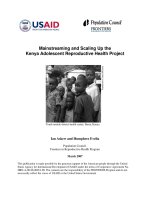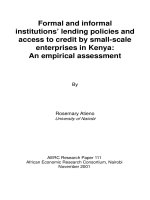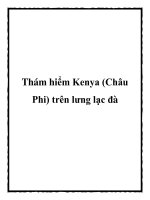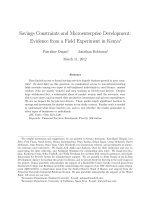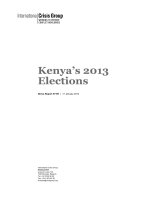Actuarial profin Kenya
Bạn đang xem bản rút gọn của tài liệu. Xem và tải ngay bản đầy đủ của tài liệu tại đây (673.44 KB, 53 trang )
International Actuarial Association
Building up the Actuarial Profession in Africa
The Actuarial Profession in Kenya
Sundeep K Raichura
Presented at 3rd International Meeting of Leaders of
the Actuarial Profession in Africa
8 June 2007
Agenda
About The Actuarial Society of Kenya
History
Objectives
Structure
The actuarial profession in Kenya
Numbers and areas of practice
Actuarial education
Statutory roles
Pensions and insurance sectors in Kenya
Challenges facing the actuarial profession in Kenya and industry
issues
Update on some relevant TASK initiatives
About TASK
The Actuarial Society of Kenya
Registered 1993
Launched in 2005
Brings together qualified and trainee actuaries in
professional, educational and research organisations
with an aim of promoting the actuarial profession in
Kenya and E Africa
TASK functions through its governing Council and
Committees (functional, administrative and ad hoc)
Work on three year Strategic Plan in progress
TASK Vision
“To position the Actuarial Profession in Kenya and the
region as the leading profession in the areas of
modeling and management of financial risks and
contingent events”
Key TASK Objectives
–
–
–
–
–
–
–
–
To develop and strengthen the actuarial profession in
Kenya
To create a forum for members of the actuarial profession to
meet and exchange ideas
To support and protect members and present common
professional interests to Government and policymakers
To play an active role in actuarial education and the
development of local actuarial expertise, professional
standards and guidance
To encourage research in the development of actuarial ideas
To improve the education of financial consumers and raise
public interest issues
To broaden the scope of the actuarial profession and promote
our contribution in wider fields
To establish links with other professional associations in
Kenya and internationally with similar objects
TASK Progress to Date
Revised constitution still in draft
–
–
Considerable time spent on membership categorisation
Strong pressure to include special Associate categorisation for nonstatutory work
Intent to become full member of IAA by end 2007
–
–
–
–
Committee working on professional code of conduct, which includes
IAA common principles of GCAE
And Disciplinary process
Formal process for adoption of standards of practice
Borrowing heavily from other actuarial associations for code of
conduct and guidance notes
TASK Progress to Date
No of working committees
–
–
–
Membership & PR, Retirement and other Employee Benefits,
Insurance and Health Care, Professionalism, Education and
Research, Investments and Wider Fields, Secretarial Finance
and Fund Raising
Disciplinary and Appeals
Performance erratic
Strategic Plan – needs wider input
The Actuarial Profession in Kenya
Numbers
4 qualified actuaries
–
–
40 partly qualified currently working in field
–
–
–
•
3 Fellows of the Institute of Actuaries
1 Associate of the Society of Actuaries
Excludes those who have graduated from local Unis with actuarial
science degrees
Many have given up on actuarial examinations
Good number has dropped actuarial examinations for CFA
Over 500 actuarial students at three local Unis:
–
–
–
UoN - started 2000, currently about 240 students, intake of 60 per
year, 60ish already graduated
JKUAT - started 2002, currently over 500, intake of 200
Maseno – started 2006, first intake of 30 students
Actuarial Education
Degree programmes aim to teach full core technical subjects
excluding ACC
–
–
–
–
–
–
–
Programme attracting brightest and talented students
But still need to assess minimum entry standards
Large streams
Academic staff likely to be strained
Bigger issue of capacity of market to absorb actuarial graduates in traditional
fields (life insurance companies and consulting firms)
Uni programmes not accredited
Also undergrads seem not to be able to register with IoA and do IoA exams
whilst in college
TASK committed to supporting local Uni programmes
–
–
–
Resource and time constraint
Two qualified actuaries have offered to teach
& Participate in course reviews and examination marking
Areas of employment
Actuarial work as employee of:
–
–
–
–
–
–
–
–
Life insurers
Health care organisations
General insurers
National social security schemes
Complementary pensions
Investment company
Regulator or Govt Departments
Banks
:
:
:
:
:
:
:
19
3
None
None
None
3
6
15
Consulting actuary working mainly in:
–
–
–
–
–
–
Life insurance
Heath care
General insurance
Social security
Pensions
Investment
:
:
:
:
:
3
2 (part of time)
Not much
2 (part of time)
12
3
Statutory Roles & Issues – Insurance
Insurance Act Cap 487
– Actuarial certification of long term insurance premium rates
– Annual statutory actuarial valuations of life funds
– Independent actuary report on mergers, acquisitions
– Actuary defined a FIA or FFA or such other as approved by
Commissioner
– Note Dept upgraded as Insurance Regulatory Authority from 1
May 2007
– Full review of Insurance Act underway – RBC and RB solvency
margins
–
–
–
No statutory actuarial role for non-life or health care currently
Position paper lobbying for actuarial certifications of technical
provisions and of insurer financial condition submitted
TASK hopes to play key role in review of Insurance Act
Statutory Roles & Issues – Pensions
Retirement Benefit Act No 3 of 1997
– Triennial actuarial valuations of DB schemes
– Minimum funding actuarial valuations (no prescribed basis) and statutory
remedial plans
– Actuarial certifications of amendments effecting financial health
– Actuarial evaluation on winding up
– Actuarial certifications of transfer values and commutation terms
– Initial statutory requirement for actuarial reviews of DC schemes dropped in 2004
– Regulations on scheme conversions being prepared
– Actuary defined as person recognised as such by IoA, FoA, SoA, CIA, AIA, JIA
–
Some provisions in Income Tax Rules on treatment of actuarial surpluses and
deficits
Snapshot of Insurance Industry in Kenya
46 companies of which 23 transact life
Most life companies composite
Estimated total annual premium 2007 of K Shs 40bn (US$ )
comprising:
–
–
–
K Shs 12bn (US$ )
K Shs 28bn (US$ )
Estimated total assets of K Shs 100bn (US$ )
–
Life
Non –life
Life
Non-life
K Shs 55bn (US$ )
K Shs 45bn (US$ )
Total aggregate share capital 2005 estimated at K Shs 30bn with
total disclosed profit of K Shs 4bn
No company has resident qualified actuary and only a handful
have actuarial departments
Snapshot of Retirement Industry in Kenya
Sector comprises:
–
–
–
Unfunded PAYG PSSA
NSSF – DC provident fund (K Shs 60bn est)
Occupational schemes (K Shs 170bn est)
Legislation has focused on enhancing protection of members’
benefits and improving governance of schemes
Pronounced trend to DC – particular concerns re contribution
rates, distribution and equity of allocation of returns to member
accounts, conservative investment strategies, member
communication
Re-engineering of public service schemes
Dichotomy of debate re pensions reform
National Pensions Policy proposed with co-ordinated strategy
–
–
–
Studies to introduce universal zero pillar social assistance programme
Reform of NSSF
Proposed conversion of PSSA to NDC for new entrants
Challenges facing Actuarial
Profession in Kenya
Lack of understanding and hence appreciation by industry and regulators of the
whole set of services that actuaries can offer
Most life insurance companies will only call actuaries to undertake yearly actuarial
valuations and certify rates for new life products
Trend to DC limiting traditional DB actuarial role
Perceived high cost of actuarial services
Effective implementation of actuarial recommendations
Actuarial education, resource and capacity constraints and lack of accreditation
Capacity of market to absorb actuarial science graduates in traditional fields –
frustration and disillusionment of actuarial graduates
Challenge from other courses – CFA
Mentoring and training of students
Wider fields not happening and hard sell, but some individual actuarial graduates
have done well in banks, investment houses and IT
Challenges facing Insurance and
Pension Sectors in Kenya
Insurance Industry
– Low level of penetration of insurance particularly life insurance
– Customer focus, marketing and distribution strategies, product innovation
– Trained man-power across the insurance value chain
– IT and processes
– Operational, financial and risk management strategies
– Pricing and reserving
– Lack of data and statistics
– Fierce competition and rate under-cutting
–
–
–
Insolvencies and financial distress of insurers and HMOs
Move to fair value accounting and risk based capital
Insurance company taxation
Challenges facing Pension Sectors
in Kenya
Low coverage
Move to DC and associated challenges
Public sector scheme actuarial deficits
Pensions policy dichotomy
Challenges can in fact be opportunities for
actuarial profession in Kenya
Update on some relevant TASK
initiatives
Strategic Plan
IAA membership – code of conduct etc
Formal internship programmes
Actuaries to volunteer to teach at local Uni programmes
Proposal to regulate role of actuarial profession in Kenya and TASK as
statutory professional body
Forum for regulators and policy makers
Forum for CEOs of insurance companies
Work done by actuarial firms on developing mortality tables for insured
lives and testing of motor insurance rates for Association of Kenya
Insurers
Project ideas and sponsorships for students
Project on comparison of international insurance and pensions regulations
Two position papers to date to Ministry of Finance
Actuarial appreciation course in the local insurance syllabus
Need for more member meetings and forums – two monthly forums
Professionalism course for actuarial practitioners
TASK Vision 2010
Achieve full IAA membership – 2008
Vibrant and dynamic actuarial profession
Strengthen statutory roles in traditional fields
Local universities accreditation – 2010
Participate actively in International Congress of
Actuaries in SA 2010
Help we need and suggestions
–
–
–
Collaboration with IAA and African actuarial associations
IAA assistance on education strategy
Regular interaction with peers in Africa and other countries
INSURANCE INSTITUTE OF KENYA
20th ANNUAL CONFERENCE
Paradigm Shift : Managing for High Performance
Redefining our Core Business: An Underwriters Perspective
Sundeep K Raichura
18 Nov 2005
Paradigm Shift:
Managing for High
Performance
How do we define high performance
from an insurer’s perspective?
Managing for High
Performance
Questions to a ‘high performing’ composite insurer:
–
–
–
–
–
–
–
–
–
–
–
–
–
What was increase in gross premiums?
To what extent did increase in gross premium translate to increase in
profitability?
What was relative performance of life/non-life business?
What was underlying profitability of individual products? Lines of business?
Which areas did well? Which did not? Why? Which products are adding value?
Which products are being subsidised?
What was relative performance of ‘offices’?
Were actual premiums consistent with pricing basis?
Was profit underwriting, investment, other? By class? If underwriting, source?
What was expense ratio? Expense overruns? Were profits due to lapses?
Trade-off between profitability v solvency?
What was year on year return on shareholders’ equity? Did it meet shareholders’
hurdle rate?
How was profitability measured? Statutory? Realistic?
Is the capital adequate given the level of business? Etc etc etc
Insurance business a complex business; multi-faceted, multi-risk carrier
TABULATED PRÉCIS OF THE
INSURANCE INDUSTRY
.
YEAR
AMOUNT
Shareholders' funds
Assets
Gross Direct Premium written
Net Direct Premium written
Invested assets
Investment income
Claims incurred (Non-life business)
Expenses of management
Commissions
Expense ratio (by NP)
Operating profit/loss
Underwriting results (Non-life business)
1997
K sh '000'
1998
K sh '000'
1999
K sh '000'
2000
K sh '000'
2001
K sh '000'
2002
K sh '000'
2003
K sh '000'
13,203,059.0
21,067,241.0
20,747,543.0
21,026,280.0
20,281,561.0
20,332,880.0
26,923,695.0
56,417,196.0
62,399,429.0
64,932,378.0
67,624,928.0
66,352,084.0
72,350,428.0
87,157,032.0
18,398,461.0
19,380,748.0
21,032,191.0
20,867,645.0
23,195,308.0
25,912,418.0
29,215,744.0
11,850,795.0
13,141,135.0
14,923,299.0
15,647,198.0
16,799,511.0
18,597,906.0
21,236,698.0
47,644,311.0
49,632,790.0
51,133,519.0
53,551,478.0
53,320,718.0
59,000,385.0
70,714,150.0
5,214,426.0
6,454,448.0
5,016,847.0
4,400,794.0
4,587,193.0
4,883,535.0
2,455,714.0
8,285,791.0
8,437,786.0
8,073,543.0
8,939,723.0
7,044,033.0
765,510.0
7,933,129.0
3,887,820.0
4,439,161.0
5,330,223.0
5,380,743.0
5,654,857.0
5,999,316.0
7,009,998.0
2,232,782.0
2,331,290.0
2,499,853.0
2,591,675.0
2,422,253.0
2,620,406.0
3,201,677.0
0.52
0.52
0.52
0.51
0.48
0.46
0.48
1,623,178.0
1,938,458.0
1,180,117.0
1,433,121.0
1,654,413.0
1,951,719.0
2,843,659.0
(576,398.0)
(113,494.0)
(136,608.0)
(579,835.0)
218,669.0
296,520.0
250,842.0
Market penetration (I.e gross premiums to GDP has remained around 3% for the last
five years
Source : Report of the Commissioner of Insurance for y/e 31 Dec 2003



